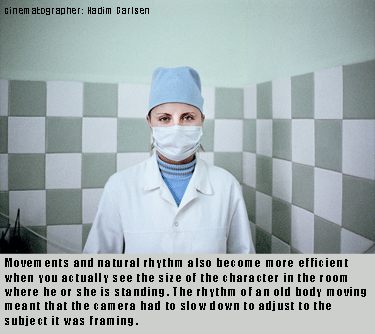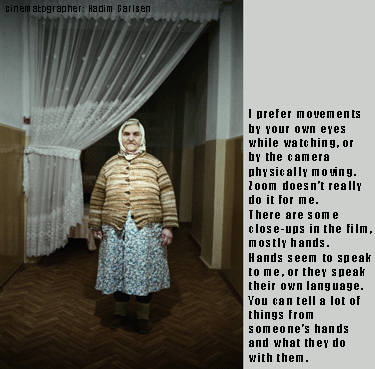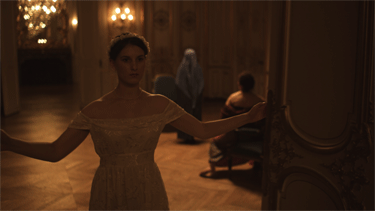|

CL: There is a scene in which the women read in the newspapers (which you show) about the Swedish royal family: some approach it with seriousness and melancholia, others with irony and cynicism. What did you feel these women's closest connection with Sweden was, apart from the language which they still speak?
AE: The language is, by all means, their closest connection to Sweden. And the language spoken connects them to me. But they also have a strong "mental" connection to Sweden. A few women tried to go to Sweden but were in the end denied visas by the Swedish authorities. When the king of Sweden visited them a couple of years ago I think they were surprised by the attention they got and felt chosen. I prepared the scene by bringing some royal magazines with me from Sweden. What we see in the scene is their reaction to it. I wanted a scene where they would automatically speak from their hearts. They told me, and each other what came to their mind when they saw the pictures.
CL: Were Lida and other women (babas) cooperative, i.e. willing to participate in the film?
AE: I showed my respect and I think by being clear of what I wanted while not pushing it, they liked being filmed. They were sweet and simple people to be around.
CL: Did anyone feel the camera was an "intruder" on their life, did they object to any scenes being made?
AE: The authorities at the local old peoples home got a little bit frustrated with me on the last day when we filmed in the dining room, for what to them, seemed to be the hundredth time.. The caretakers couldn't quite see what was so interesting with filming people eating but they never objected. In the end they were happy when they saw how pleased the old people were by our visit. Lida did object once. She did not want to go outside to the graveyard because of the cold. That scene was instead made with her friend Lucia, a younger woman who luckily owned a coat and a pair of proper shoes.
CL: Did this filmmaking experience make you ask yourself more general questions on film form and meaning: intrusions on someone's reality, on the voyeuristic gaze of the camera, especially when dealing with the "real people's real life", who might be completely exposed?
AE: I am not afraid of showing something, as long as I can explain to myself why this particular scene is important for the film, and as long as it feels true to me. I agreed with my cameraman that we would not have any boundaries while shooting. If any moral/intrusions were to be considered, it was going to be considered by me in the editing room. You feel strongly when it is ok or not to shoot while you are in it.
I did make a scene with a man dying of cancer. One of the scenes is hard. He is in great pain while showing his stomach and gasping for a breath. All the scenes with him did not make it to the final film. His story demanded a lot more explanation and I could not make it fit.
CL: Your film's tone, finely balanced with subtle humour, exudes sympathy for the characters. Do you feel that female and male camera gaze need redefinition?
AE: I do what feels right for me. I am a big admirer of both Pirjo Honkasalo, who is a woman, and of Ulrich Seidl, who is a man. Their gender doesn't really affect my way of viewing their films. I believe that it is the person behind the film that is interesting. What you choose to portray in your film is highly personal, and doesn't necessarily reflect your gender orientation.
CL: What is the position, the role of a female documentary filmmaker today?
AE: The position of women filmmakers in Denmark is strong. But the "woman"- stamp is, to me, not very equal-thinking. It creates an expectation telling us that women make a certain types of films, and men, oh well, they just make films. I myself am dreaming of an overall more genderless working space.
CL: Did you have any difficult moments during the filming?
AE: I would prefer to see it as "conditions during filming" rather than difficulties. But the lack of lightening in the evening made it impossible for us to shoot after nightfall. The weather condition were pretty hard, so outdoor scenes was a cold experience. I was very pleased after shooting the scene with the two people walking in the fog. That was one instant cinematic documentary moment I'll never forget.
CL: The film's photography is stunning. Is this your first cooperation with Nadim Carslen?
AE: I had seen an exhibition of a series of still photographs by Nadim and was very impressed by his work. While getting to know him, I found he had the sense of presence in working with images that I love and find essential in filmmaking. We now have developed a certain way of working together and there is a great amount of trust between us. Since Baba we often meet and see a lot of films together, talk and look a lot at pictures and paintings.
CL: Most tableaux-scenes are dark, sometimes set against some green pastel tones, as if to convey the somber lives of these women? Did you choose to film during cold Christmas days to match their sadness and loneliness at such festivities?
AE:The use of tableaux-like pictures was chosen to strengthen the presence of the surroundings in the film. By showing a scene in a slightly larger framing I could let details from a tapestry or carpet on the wall tell stories without words. I could show the cold, by picturing women wearing hats and knitted fabrics while being inside. In a place where you are not overexposed by electric light, the natural light plays an important role on when your day starts and when you go to sleep. And you can see the natural lighting more clearly in a larger framed picture than in a close-up.
|
|
My cinematographer was more or less banned to get too close to the subjects.Movements and natural rhythm also become more efficient when you actually see the size of the character in the room where he or she is standing. The rhythm of an old body moving meant that the camera had to slow down to adjust to the subject it was framing.
I do not think that you are taking a distance from your character by shooting from a distance. I think it is a different way of telling a story, you are intentionally using the surrounding objects to help drawing your character. I prefer movements by your own eyes while watching, or by the camera physically moving. Zoom doesn't really do it for me. There are some close-ups in the film, mostly hands. Hands seem to speak to me, or they speak their own language. You can tell a lot of things from someone's hands and what they do with them.
I did not aim on capturing their feeling of sadness at Christmas time, but more I was hoping for some traditional festivity to take place, but that just did not happen. They were like many other things, just small traces from the past.

CL: Carefully edited and with a balanced distance for the spectator, your film adheres in a verité style to the completely unscripted and unpredictable reality – as you see it - and yet, the mise-en-scene is superbly stylized as in a fiction film. And you are an autodidact. What are you film influences, inspirations in general?
AE: That is a flattering way of putting it, thank you. Carlos Reygadas is an inspiring director because of his use of lightening and choice of characters, set ups and places for his films. I am fond of the humour in the films of Roy Anderson. The harsh reality check of Ulrich Seidls documentary films are admirable films in my eyes. There is also a forgotten Russian documentary film called Belovy which is worth seeing when it comes to staging reality and working with the film crew versus the reality. Other influences come from Marcel Proust, Joseph Beuys and Vladimir Nabokov.
CL: Have the babas and the Swedish audience seen the film? What was the reaction?
AE: I want to show the film to the people in the village, but I haven't figured out when and how yet. Some of them saw parts of our dailies and their response to it was good. People in Sweden have showed a big interest, and depending on their age and occupation. Older people like it because it has old people in it, and they find the historical background interesting. Younger ones tend to ask more questions about the form of the film. Some have been a bit provoked by it. People in New Zeeland love it.
CL: You made these women visible to the wider audiences. Although it might be late for the lives of these women, would you have liked your film to have a greater social & political impact?
AE: I guess you can always dream of film being a political tool. Sometimes it does succeed, like Frederick Wisemans Titticut Follies made a huge impact on the American hospitals back in the 60s. I think by choosing to film on locations like this, there will always be a kind of political statement involved. But my film is not going to chance the lives of people living on the countryside in Ukraine. One can always hope that it has an impact on its viewers. For me, what documentary films can, is to open other peoples eyes' to a world they didn't know they could get to know. And my reasons are as much in my own private interests, also in trying to put things on an edge, always redefine the cinema experience.
CL: Where are you filming next?
AE: My next film is about a group of teenagers in an Indian reservation in the United States. It will be a poetic experience. I recently shot the opening scene of a short film in the United States, and will be shooting the rest of that film in Russia starting in January.

Interview: Lina Mannheimner
The Contract
Contract of love
Lina Mannheimer has a degree in Art, Film & Culture from the Universidad de Nebrija in Madrid and studied Business and Economics at the Stockholm School of Economics. She has worked closely with the French director Gilles Bourdos (Afterwards) and at the New York-based independent production company Salty Features. In 2009, Mannheimer completed a Master's degree in International Co-Production at the Gothenburg Film School, a program specializing in the European Co-Financing of feature films. Her thesis studied the economic, social and cultural factors of such agreements and how they affect the artistic outcome of the films. In 2009, Mannheimer began developing a documentary about French writer Catherine Robbe-Grillet. The Contract is her debut and also the first part of the project The Ceremony.
|




